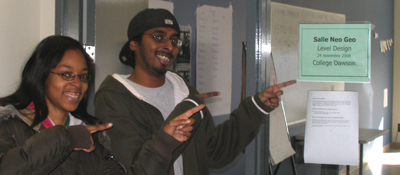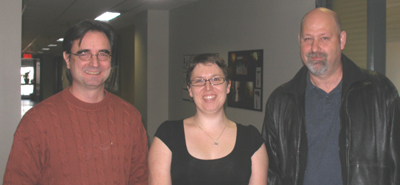The Architects of Fun in the Pipeline with Animators and Modelers
At Montreal’s Ubisoft Campus, Dawson College, Cégep de Matane and Cégep du Vieux-Montréal have formed a consortium to offer and develop three college level programs:
- Video Game Level Design,
- 3D Animation for Video Games and
- 3D Modeling for Video Games
Level designers are concerned with the layout of space and gameplay, that is, what a player does in the level and not how the level looks. Level designers have been described as the architects of fun. The art team, which includes modelers and animators are responsible for the way the level looks. In November 2007, Dawson College began to offer an AEC in Video Game Level Design and began offering 3D Animation for Video Games in 2009.
It is well known that play is essential for the development of motor, cognitive and social skills in both animals and humans. Free play has also been linked to adaptability in adults. Games structure play through rules to evoke specific behaviours and interactions. The desire to submit to the magic circle of a game is often balanced by the desire to create one’s own games. My feeling is that this impulse comes from another basic need, the desire to gain control over one’s own destiny, to self-actualize.
Video games are now the primary platform for playing games and have become the leading edge for learning. Although Ubisoft campus is designed to train students for industry jobs, many students here are learning through games, and not just how to build them. While creating a game world, students learn about subjects outside of games as they must bring various aspects of "reality" into their levels. Research is a major part of their jobs, but has a wider educational value.
One of the more innovative aspects of these gaming program curricula is that during the last semester the Level Designers, Modelers and Animators work together to produce a video game. Students from each specialized program, under the supervision of teachers playing the roles of producers, directors and leads, are organized into a production pipeline and set about creating an immersive and engaging game world.
Although each program teaches a separate discipline needed to produce games, there are six common courses and 11 common competencies. Most of the common courses are in the first semester. Here, students learn enough about each other’s disciplines so they can communicate and work effectively in a team. Since team work is so critical in industry, there is a common course dedicated to communications and team-building. Being creative is a skill that cuts across all programs and there is a course that teaches creativity techniques as applied to each discipline. During the second term students specialize.

Two students point to a sign identifying that one of the Ubisoft campus’s classrooms, which are named after video games, is currently assigned to a group of Dawson students.
The three programs were revised by the consortium in 2008. The final ‘project semester’ now consists of two courses instead of one. The project course of 405 hours was supplemented by a production techniques course of 120 hours. In the production techniques course, students meet once weekly as a team to organize and develop a video game in the same way industry game developers do. Emphasis is placed on the development of a production schedule and adherence to the schedule, problem solving and working effectively as a production team. These are skills that students need to have in the industry, yet students have very little chance of getting familiar with such an environment as video games companies are wary of creating internships whose participants could divulge privileged information.

The programs attracted a talented and dedicated faculty from the ranks of industry. Brent George is a leading animation artist as is Art Animation director James Cameron from the Avatar game. Other faculty include David Sear from Seattle who is working at Ubisoft and for Dawson and is director of the Navy Seals franchise. François Renous is pictured above at left. Annick Dumais is pictured above at center and is from UBisoft. The CVM faculty include staff from AMM Artificial Mind and Movement, a Quebec company.
Because faculty feedback indicated that students and faculty were putting in much more time during the project semester than 360 hours, the last term was extended from 360 hours to 525 hours. Teachers felt that the original time-frame was insufficient to create a video game and the current arrangement is augmented by student work outside of scheduled studio time. The project semester recreates the same pressures as found in the industry reflected in late night work fuelled by pizzas!
The video game design curriculum has demonstrated the value of games in education in general. Educators can leverage the net generation’s fixation on interactive technology and their passion for play into a wider education. The future of education may be seen in NASA’s MMO Project, Astronaut: Moon Mars and Beyond. A massive multiplayer online game, Astronaut: Moon Mars and Beyond is a serious game set up to deliver Curriculum. "Players" can do science experiments with friends and classmates, earn accreditation to unlock gear, and work in multidisciplinary teams to build their own bases. Educators play an important role as team leaders. Serious games have become a reality rendered possible thanks to Information and Communication Technology.

